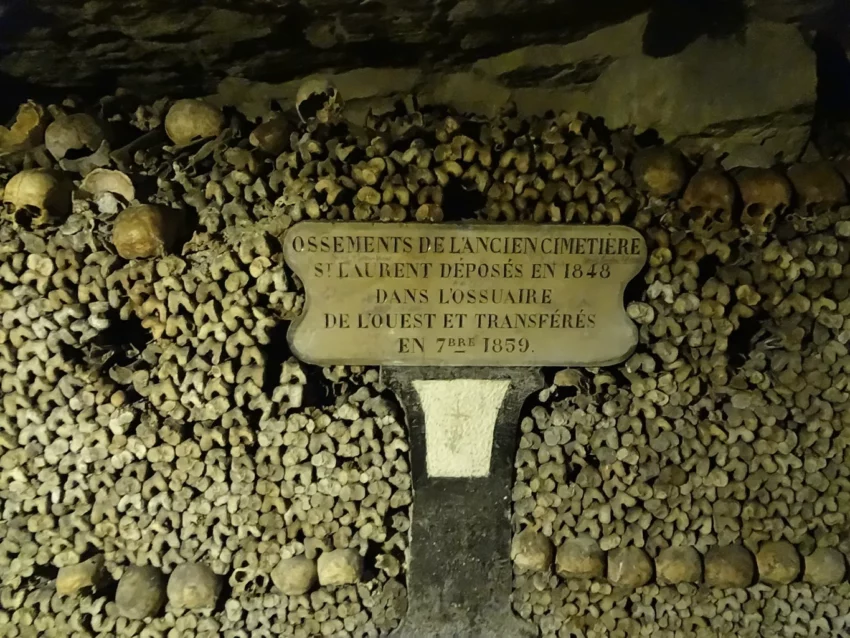The Catacombs of Paris: A Subterranean Ossuary
The Catacombs of Paris, an extensive network of underground ossuaries beneath the French capital, serve as the final resting place for over six million individuals. This subterranean labyrinth, extending south from the former Barrière d’Enfer city gate, was established to address the issue of overflowing cemeteries and consolidate the city’s ancient stone quarries. The urgency to create this ossuary was heightened following a series of basement wall collapses near the Holy Innocents’ Cemetery in 1774. The transfer of remains from Paris’s cemeteries to the catacombs began in 1786, a process that involved nightly processions of covered wagons to a mine shaft near Rue de la Tombe-Issoire.
Get your dose of History via Email
Initially forgotten, the catacombs gained attention in the early 19th century, hosting concerts and private events. Following renovations and the construction of access points around Place Denfert-Rochereau, they were opened for public visitation in 1874. Since 2013, the Catacombs have been part of the fourteen City of Paris Museums managed by Paris Musées. Despite comprising only a small section of Paris’s underground mines, the entire tunnel network is often referred to as the catacombs by locals.
History of Paris’ Cemeteries
The history of Paris’s cemeteries dates back to the Roman-era Left Bank city, with burial grounds initially located on the southern outskirts. Following the decline of the Western Roman Empire and subsequent Frankish invasions, Parisians moved to the Right Bank, establishing cemeteries near the city center. The most central of these, around the 5th-century Notre-Dame-des-Bois church, eventually became overcrowded, leading to the exhumation of long-dead individuals to make room for new burials. By the late 18th century, the Saints Innocents cemetery had become a mound of earth filled with centuries of Parisian dead, prompting the decision to create new suburban burial grounds and condemn existing parish cemeteries within city limits.
The Future Ossuary: Paris’s Former Mines
The Left Bank of Paris sits atop rich Lutetian limestone deposits, which were extensively mined from the 12th century onwards. These often illicit and uncharted mines were abandoned once depleted, leading to a series of mine cave-ins in the 18th century. This prompted King Louis XVI to establish the Inspection Générale des Carrières service to investigate the state of the Parisian underground and ultimately led to the creation of the catacombs as a solution to the city’s cemetery crisis.
Ossuary Creation
The collapse of a basement wall adjoining the Les Innocents cemetery in 1780 underscored the urgency of addressing the intra muros cemetery issue. The renovation of the “Tombe-Issoire” passageways and the decision to move Parisian dead to these underground sepulchres marked the beginning of the catacombs. From 1786, the remains of millions were transferred from Paris’s cemeteries to the catacombs, including notable victims of the French Revolution.
Renovation and Ossuary Decor
Under the direction of Louis-Étienne Héricart de Thury in the early 19th century, the catacombs were transformed into a visitable mausoleum. Skulls and femurs were arranged into decorative patterns, and cemetery decorations were used to complement the walls of bones. This renovation also included the creation of rooms dedicated to displaying minerals found under Paris and various skeletal deformities.
Modern Era
The catacombs have played various roles in modern history, from serving as the headquarters for the French Resistance during World War II to hosting a clandestine movie theater discovered in 2004. They have also been the site of unique events, such as an Airbnb publicity stunt in 2015 and a significant wine theft in 2017. Despite these modern incursions, the catacombs remain a historical monument, open to the public and serving as a reminder of Paris’s complex relationship with its dead.
The Catacombs of Paris, with their rich history and unique status as an underground ossuary, continue to fascinate both Parisians and visitors from around the world. They stand as a testament to the city’s historical efforts to manage its dead and the ongoing allure of its subterranean mysteries.
Sources:

